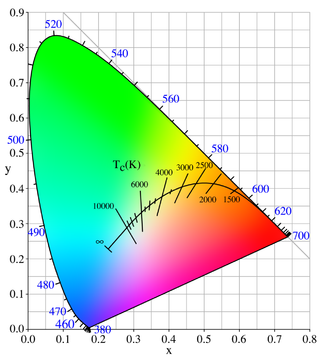
Color temperature is a parameter describing the color of a visible light source by comparing it to the color of light emitted by an idealized opaque, non-reflective body. The temperature of the ideal emitter that matches the color most closely is defined as the color temperature of the original visible light source. Color temperature is usually measured in kelvins. The color temperature scale describes only the color of light emitted by a light source, which may actually be at a different temperature.

In colorimetry, metamerism is a perceived matching of colors with different (nonmatching) spectral power distributions. Colors that match this way are called metamers.

A fluorescent lamp, or fluorescent tube, is a low-pressure mercury-vapor gas-discharge lamp that uses fluorescence to produce visible light. An electric current in the gas excites mercury vapor, which produces short-wave ultraviolet light that then causes a phosphor coating on the inside of the lamp to glow. A fluorescent lamp converts electrical energy into useful light much more efficiently than an incandescent lamp. The typical luminous efficacy of fluorescent lighting systems is 50–100 lumens per watt, several times the efficacy of incandescent bulbs with comparable light output. For comparison, the luminous efficacy of an incandescent bulb may only be 16 lumens per watt.

The Kruithof curve describes a region of illuminance levels and color temperatures that are often viewed as comfortable or pleasing to an observer. The curve was constructed from psychophysical data collected by Dutch physicist Arie Andries Kruithof, though the original experimental data is not present on the curve itself. Lighting conditions within the bounded region were empirically assessed as being pleasing or natural, whereas conditions outside the region were considered uncomfortable, displeasing or unnatural. The Kruithof curve is a sufficient model for describing pleasing sources that are considered natural or closely resemble Planckian black bodies, but its value in describing human preference has been consistently questioned by further studies on interior lighting.

Lighting or illumination is the deliberate use of light to achieve practical or aesthetic effects. Lighting includes the use of both artificial light sources like lamps and light fixtures, as well as natural illumination by capturing daylight. Daylighting is sometimes used as the main source of light during daytime in buildings. This can save energy in place of using artificial lighting, which represents a major component of energy consumption in buildings. Proper lighting can enhance task performance, improve the appearance of an area, or have positive psychological effects on occupants.

High-intensity discharge lamps are a type of electrical gas-discharge lamp which produces light by means of an electric arc between tungsten electrodes housed inside a translucent or transparent fused quartz or fused alumina arc tube. This tube is filled with noble gas and often also contains suitable metal or metal salts. The noble gas enables the arc's initial strike. Once the arc is started, it heats and evaporates the metallic admixture. Its presence in the arc plasma greatly increases the intensity of visible light produced by the arc for a given power input, as the metals have many emission spectral lines in the visible part of the spectrum. High-intensity discharge lamps are a type of arc lamp.

A compact fluorescent lamp (CFL), also called compact fluorescent light, energy-saving light and compact fluorescent tube, is a fluorescent lamp designed to replace an incandescent light bulb; some types fit into light fixtures designed for incandescent bulbs. The lamps use a tube that is curved or folded to fit into the space of an incandescent bulb, and a compact electronic ballast in the base of the lamp.
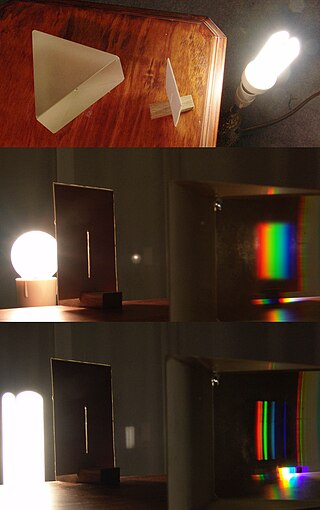
A color rendering index (CRI) is a quantitative measure of the ability of a light source to reveal the colors of various objects faithfully in comparison with a natural or standard light source. Light sources with a high CRI are desirable in color-critical applications such as neonatal care and art restoration.
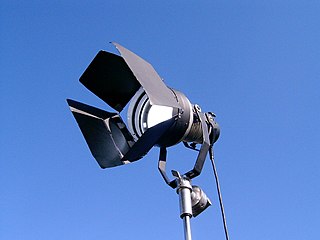
Hydrargyrum medium-arc iodide (HMI) is the trademark name of Osram's brand of metal-halide gas discharge medium arc-length lamp, made specifically for film and entertainment applications. Hydrargyrum comes from the Greek name for the element mercury.

In physics and color science, the Planckian locus or black body locus is the path or locus that the color of an incandescent black body would take in a particular chromaticity space as the blackbody temperature changes. It goes from deep red at low temperatures through orange, yellowish, white, and finally bluish white at very high temperatures.
A white point is a set of tristimulus values or chromaticity coordinates that serve to define the color "white" in image capture, encoding, or reproduction. Depending on the application, different definitions of white are needed to give acceptable results. For example, photographs taken indoors may be lit by incandescent lights, which are relatively orange compared to daylight. Defining "white" as daylight will give unacceptable results when attempting to color-correct a photograph taken with incandescent lighting.
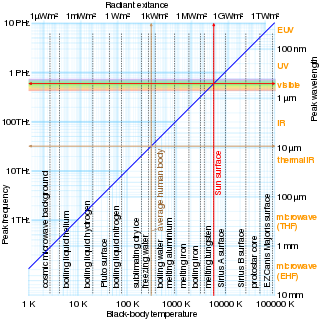
The correlated color temperature is defined as "the temperature of the Planckian radiator whose perceived color most closely resembles that of a given stimulus at the same brightness and under specified viewing conditions."
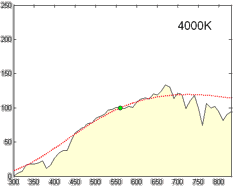
Full-spectrum light is light that covers the electromagnetic spectrum from infrared to near-ultraviolet, or all wavelengths that are useful to plant or animal life; in particular, sunlight is considered full spectrum, even though the solar spectral distribution reaching Earth changes with time of day, latitude, and atmospheric conditions.

A ceramic metal-halide lamp (CMH), also generically known as a ceramic discharge metal-halide (CDM) lamp, is a type of metal-halide lamp that is 10–20% more efficient than the traditional quartz metal halide and produces a superior color rendition.
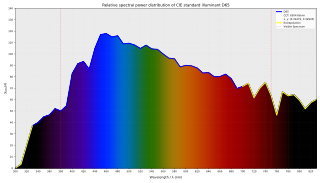
CIE standard illuminant D65 (sometimes written D65) is a commonly used standard illuminant defined by the International Commission on Illumination (CIE). It is part of the D series of illuminants that try to portray standard illumination conditions at open-air in different parts of the world.
Color correction is a process used in stage lighting, photography, television, cinematography, and other disciplines, which uses color gels, or filters, to alter the overall color of the light. Typically the light color is measured on a scale known as color temperature, as well as along a green–magenta axis orthogonal to the color temperature axis.

A standard illuminant is a theoretical source of visible light with a spectral power distribution that is published. Standard illuminants provide a basis for comparing images or colors recorded under different lighting.

An LED lamp or LED light is an electric light that produces light using light-emitting diodes (LEDs). LED lamps are significantly more energy-efficient than equivalent incandescent lamps and fluorescent lamps. The most efficient commercially available LED lamps have efficiencies exceeding 200 lumens per watt (lm/W) and convert more than half the input power into light. Commercial LED lamps have a lifespan several times longer than both incandescent and fluorescent lamps.
Color quality scale (CQS) is a color rendering score – a quantitative measure of the ability of a light source to reproduce colors of illuminated objects. Developed by researchers at NIST the metric aims to overcome some of the issues inherent in the widely used color rendering index.
The color rendering of a light source refers to its ability to reveal the colors of various objects faithfully in comparison with an ideal or natural light source. Light sources with good color rendering are desirable in color-critical applications such as neonatal care and art restoration. It is defined by the International Commission on Illumination (CIE) as follows:
Effect of an illuminant on the color appearance of objects by conscious or subconscious comparison with their color appearance under a reference illuminant.















